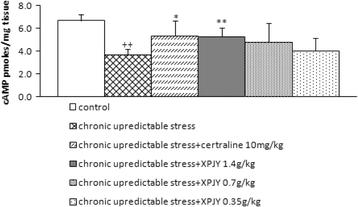Effect of XingPiJieYu decoction on spatial learning and memory and cAMP-PKA-CREB-BDNF pathway in rat model of depression through chronic unpredictable stress
- PMID: 28118829
- PMCID: PMC5260079
- DOI: 10.1186/s12906-016-1543-9
Effect of XingPiJieYu decoction on spatial learning and memory and cAMP-PKA-CREB-BDNF pathway in rat model of depression through chronic unpredictable stress
Abstract
Background: Depression is a mental disorder characterized by a pervasive low mood and loss of pleasure or interest in usual activities, and often results in cognitive dysfunction. The disturbance of cognitive processes associated with depression, especially the impairment of learning and memory, exacerbates illness and increases recurrence of depression. XingPiJieYu (XPJY) is one of the most widely clinical formulas of traditional Chinese medicine (TCM) and can improve the symptoms of depression, including learning and memory. However, its regulatory effects haven't been comprehensively studied so far. Recently, some animal tests have indicated that the cyclic adenosine monophosphate (cAMP)-protein kinase A (PKA)-cAMP response element-binding protein (CREB)-brain derived neurotrophic factor (BDNF) signaling pathway in hippocampus is closely related to depression and the pathogenesis of cognitive function impairments. The present study was performed to investigate the effect and mechanism of XPJY on depression and learning and memory in animal model.
Materials: The rat model of depression was established by chronic unpredictable stress (CUS) for 21 days. The rats were randomly divided into six groups: control group, CUS group, CUS + XPJY (1.4 g/kg, 0.7 g/kg and 0.35 g/kg) groups, and CUS + sertraline (10 mg/kg) group. The sucrose preference, open field exploration and Morris water maze (MWM) were tested. The expression of cAMP, CREB, PKA and BDNF protein in hippocampus was examined with Elisa and Western Blot. The mRNA level of CREB and BDNF in hippocampus was measured with PCR.
Results: The results demonstrated that rats subjected to CUS exhibited decreases in sucrose preference, total ambulation, percentage of central ambulation, rearing in the open field test and spatial performance in the MWM. CUS reduced the expression of cAMP, PKA, CREB and BDNF in hippocampus of model rats. These effects could be reversed by XPJY.
Conclusion: The results indicated that XPJY can improve depression and related learning and memory and the effect of XPJY is partly exerted through the cAMP-PKA-CREB-BDNF signaling pathway.
Keywords: BDNF; CAMP; CREB; Chinese herbs; Chronic unpredictable stress; Depression; Learning and memory; PKA.
Figures




Similar articles
-
cAMP/PKA-CREB-BDNF signaling pathway in hippocampus mediates cyclooxygenase 2-induced learning/memory deficits of rats subjected to chronic unpredictable mild stress.Oncotarget. 2017 May 30;8(22):35558-35572. doi: 10.18632/oncotarget.16009. Oncotarget. 2017. PMID: 28415673 Free PMC article.
-
Helicid Ameliorates Learning and Cognitive Ability and Activities cAMP/PKA/CREB Signaling in Chronic Unpredictable Mild Stress Rats.Biol Pharm Bull. 2019;42(7):1146-1154. doi: 10.1248/bpb.b19-00012. Biol Pharm Bull. 2019. PMID: 31257291
-
PKA-CREB-BDNF signaling pathway mediates propofol-induced long-term learning and memory impairment in hippocampus of rats.Brain Res. 2018 Jul 15;1691:64-74. doi: 10.1016/j.brainres.2018.04.022. Epub 2018 Apr 21. Brain Res. 2018. PMID: 29684336
-
Dietary Flavonoids Interaction with CREB-BDNF Pathway: An Unconventional Approach for Comprehensive Management of Epilepsy.Curr Neuropharmacol. 2019;17(12):1158-1175. doi: 10.2174/1570159X17666190809165549. Curr Neuropharmacol. 2019. PMID: 31400269 Free PMC article. Review.
-
The effects of Chinese medicines on cAMP/PKA signaling in central nervous system dysfunction.Brain Res Bull. 2017 Jun;132:109-117. doi: 10.1016/j.brainresbull.2017.04.006. Epub 2017 Apr 21. Brain Res Bull. 2017. PMID: 28438669 Review.
Cited by
-
Neuroprotective Potency of Neolignans in Magnolia officinalis Cortex Against Brain Disorders.Front Pharmacol. 2022 Jun 16;13:857449. doi: 10.3389/fphar.2022.857449. eCollection 2022. Front Pharmacol. 2022. PMID: 35784755 Free PMC article.
-
Ameliorative Effect of Moringa oleifera Against CUMS-Induced Anxiety in Rats: β-Catenin and 5-HT1 A Crosstalk.Mol Neurobiol. 2025 Sep;62(9):11179-11195. doi: 10.1007/s12035-025-04911-8. Epub 2025 Apr 23. Mol Neurobiol. 2025. PMID: 40266546 Free PMC article.
-
Role of Ginkgo biloba extract as an adjunctive treatment of elderly patients with depression and on the expression of serum S100B.Medicine (Baltimore). 2018 Sep;97(39):e12421. doi: 10.1097/MD.0000000000012421. Medicine (Baltimore). 2018. PMID: 30278520 Free PMC article. Clinical Trial.
-
An Integrative Pharmacology-Based Pattern to Uncover the Pharmacological Mechanism of Ginsenoside H Dripping Pills in the Treatment of Depression.Front Pharmacol. 2021 Feb 15;11:590457. doi: 10.3389/fphar.2020.590457. eCollection 2020. Front Pharmacol. 2021. PMID: 33658934 Free PMC article.
-
Evaluation of the Effect of Hypericum triquetrifolium Turra on Memory Impairment Induced by Chronic Psychosocial Stress in Rats: Role of BDNF.Drug Des Devel Ther. 2020 Dec 1;14:5299-5314. doi: 10.2147/DDDT.S278153. eCollection 2020. Drug Des Devel Ther. 2020. PMID: 33299301 Free PMC article.
References
-
- Zakzanis KK, Leach L, Kaplan E. On the nature and pattern of neurocognitive function in major depressive disorder. Neuropsychiatry Neuropsychol Behav Neurol. 1998;11(11):111–119. - PubMed
-
- Banerjee R, Ghosh KA, et al. Stress. Negative Modulator of NGF. 2011;1(2):1–7.
MeSH terms
Substances
LinkOut - more resources
Full Text Sources
Other Literature Sources
Medical

